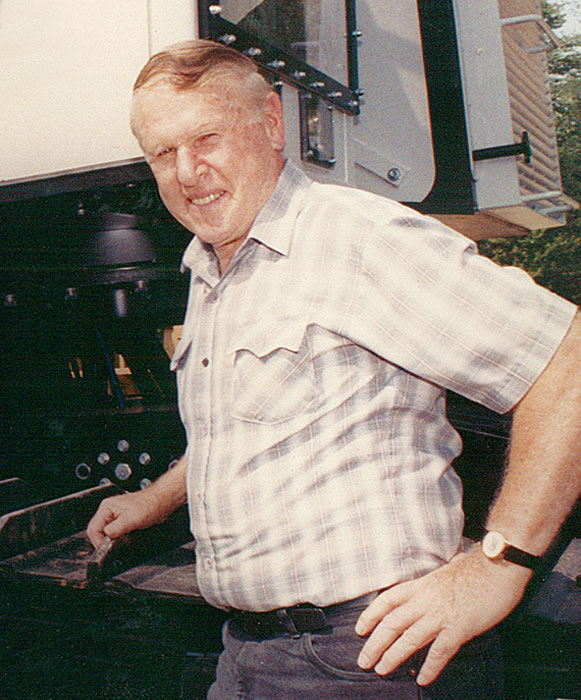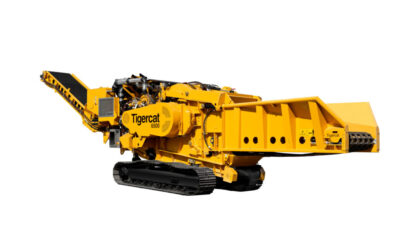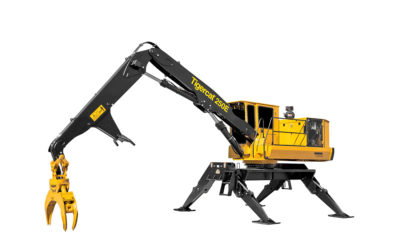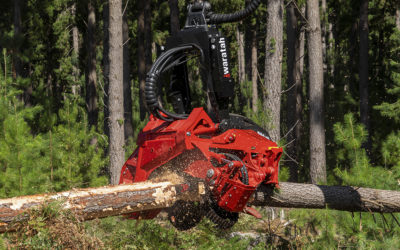Crawford Left Distinctive Footprint
Article by DK Knight, Executive Editor/Co-Publisher, Timber Harvesting September/October 2018
 For decades, loggers and manufacturers rooted in the Lake States region have made far-reaching contributions to the mechanization of timber harvesting. Consider the hydraulic loader, hydrostatic feller-buncher, landing processors on wheels, various types of slashers, shears, forwarders, delimbers and por-table debarkers, not to mention whole tree chippers.
For decades, loggers and manufacturers rooted in the Lake States region have made far-reaching contributions to the mechanization of timber harvesting. Consider the hydraulic loader, hydrostatic feller-buncher, landing processors on wheels, various types of slashers, shears, forwarders, delimbers and por-table debarkers, not to mention whole tree chippers.
One former logger who will long be remembered for advancing the mechanical march was Pat Crawford, eminent founder of the Timbco and TimberPro brands that originated in northeastern Wisconsin. Pat’s life ended on August 19 at his home in Shawano, Wisc. He was 92, the last survivor in a family of four siblings.
On August 25, the many relatives, friends and admirers of Pat gathered at Sacred Heart Catholic Church in Shawano to celebrate his standout life and numerous accomplishments. Here is what an unidentified family member posted on Facebook about that service:
“Today we said goodbye to a legend. Having a new buncher parked outside the church was really great. I’m so proud of my family for being there for each other. A huge thank you to our aunts who planned everything, the community for showing up and supporting such a wonderful man, and our friends we’ve met through business that traveled from all over the country, Canada and Europe. To say Pat was liked by a lot of people would be an enormous understatement.
“The theme of the funeral was to “Live Like Pat,” which means to be humble, kind, generous and to be the best person you can be each and every day.
“After the funeral ended a large procession headed to the cemetery to put Pat in his final resting place. The priest started the prayer, and there was a beautiful bald eagle circling above. You couldn’t help but think it was Pat looking over us. Right before the prayer ended you could hear a diesel engine running and everyone looked up and it was the buncher that was parked in front of the church passing by. What timing! Chills ran down my arms and tears rolled down my cheeks. We will miss him forever.”
As I understand it, even though his health was failing, Pat regularly peeked in at the goings on at TimberPro until the end. Being at the plant, watching machines come together, and interfacing with his family and employees, not to mention customers and dealers, was what it was all about for him.
His Life, Career
By all accounts, Pat led a most interesting and inspiring life, one marked by many ups and downs. Born in 1926 in a logging camp where his father was a logger and his mother the cook, and being brought up in the Great Depression, left a deep imprint that manifested itself in frugality, perseverance, compassion, and an enormous work ethic.
Working part-time in the camp as a youth, he finished high school at 17 and spent a year in college before joining the Army Air Corps, hoping to become a pilot. By that time the AAC had cooled its hot pursuit of new pilots, so 18 months later he returned to the woods, resumed college studies, and played minor league baseball for one summer before deciding he was not talented enough to pursue the game.
His love for the woods became stronger after he and some friends went to Montana to cut timber for a season. After returning to Wisconsin and deciding not to continue college studies, he married a girl named Ruth. Again, Pat headed West, on his honeymoon no less, and settled for a year in Oregon where he sharpened his timber falling skills before the couple returned to Wisconsin to join his father and brother, Richard, in the woods.
Soon thereafter he was almost killed when a large, dead limb broke off a tree he was cutting and hit him in the head. That mishap taught him never to take his well-being for granted and to be much more cautious.
Pat’s knack for coming up with a better way surfaced in the late ’50s when he had a cable loader mounted on the rear of a truck instead of the behind the cab, the common position. That arrangement enabled him to load both the truck and a pup trailer, enhancing trucking efficiency.
As Pat’s family grew, so did his business interests. Around 1960 Pat and Richard embraced the lumber trade, operating a small sawmill as they continued logging. That endeavor led them to buy a struggling furniture component manufacturing operation, a move that led to business and personal bankruptcy for the two. Pat and Ruth had seven kids at the time.
“You want to eat humble pie? Go bankrupt,” Pat told writer Dave Wester, who years ago wrote a history of the innovator and his companies. According to Wester, Pat did not give up; he simply worked harder. An older friend who had faith in him co-signed a loan for $15,000 so Pat could get back into logging. He cut logs all day and hauled at night. “I never worked so hard in my life,” he recalled, but there’s one thing I learned. When you’re flat on your back there’s only one way, and that’s up.” A year or so later, Pat had paid back the loan and had $5,000 in the bank.
The logger credited the Menominee Indian Tribe, which controls a 235,500-acre reservation in northeastern Wisconsin, for helping him along the way. At the invitation of the Menominee, he began logging on the reservation in 1963, earning a reputation as “the hungry white man.” That development led to the relocation of the Crawford family from northwestern to northeastern Wisconsin, where he continued to tinker and innovate.
Early Developments
In the mid-1970s he hooked up with Ed Kosinski in a small fabrication shop in Polar, Wis. that facilitated his tinkering. They developed a large forwarder, using the chassis of a military tank retriever, and Pat put it to work on his job. Others in the area wanted one. The shop eventually turned out about 35 of the machines, dubbed the Polar Prehauler.
Pat and Kosinski, along with employee Larry Klement, continued trying things, including a tree shear, the manufacturing rights for which were sold to Esco, and a wheeled feller-buncher prototype that featured a swinging boom with a shear. Pat owned a Drott track-type buncher and was using it to select cut in a national forest, but its wide tail swing was an operational drawback. He designed a new type of boom that folded over the top of the machine, greatly reducing its tail swing and making it much more productive.
The threesome fitted the shop-built wheeled buncher prototype with the boom, but encountered hydraulic troubles, so they switched to a tracked carrier and it worked well. Wester wrote that Pat considered the boom design his top innovation, the real beginning of Timbco. The year was 1978.
At that time Pat was not interested in becoming a manufacturer, preferring to build machines for his own use, but local and area loggers kept urging him to build them. He had tested other equipment for Caterpillar, so he offered his prototype to that company, but officials there did not think it was far enough along to interest them, and they turned it down. “They could have had it for nothing,” Pat recalled in Wester’s history. Pat sold his share of the Polar Welding Shop to Kosinski and invested in a place of his own in Shawano, making Klement his partner and turning over his logging job to two of his sons. At 55, Pat’s career entered a new orbit.
Despite the financial constraints and challenges that accompany startups, Pat and his Timbco family endured, producing the first Timbco in 1980 and improving the product—going from two-way to four-way leveling in 1982 was one example—and added more dealers and customers.
The machine, which really shined in steep, rugged terrain, caught the attention of Timberjack, which in the mid-’80s worked out a general assembly and marketing agreement with Timbco that lasted for several years and helped make Pat’s financial condition more secure. The companies parted ways when they could not reach accord on ownership of design changes, so Timbco resumed total production, going with an ‘engine up’ design that Pat believed would help broaden its appeal, and Timberjack introduced its own machine with the unit’s original ‘engine down’ design.
With Timbco’s business booming in the ’90s, several manufacturers made offers or overtures to buy the company. In 2000, about the time Pat had renewed his interest in wheeled machines, Timb–co agreed to sell to Partek Forest, owner of the Valmet brand.
TimberPro Emerges
Pat worked out an option to buy back the wheeled division in two years, which he did in 2002. He formed TimberPro, which initially focused on making large wheeled harvesters and forwarders and robust controlled-fall heads. Tracked machines were added later. Today TimberPro products are found around the world, and some are used in non-forestry applications
He was 77 when he formed TimberPro. “Retirement to me is a dirty word,” he told Dave Wester. “I may be old, but I don’t want to go to Florida and sit there for the rest of my life.”
Always a logger at heart, Pat drew lots of attention from forest industry publications and associations, not to mention local newspapers. Here is one example from Timber Harvesting in 1992:
As a logging contractor for most of his life, Crawford says he’s much more conscious of the end user than he is the profitability of his company. “Of course, we have to be profitable, but the fellow who’s buying our product has to make a living with it, and he’s our primary concern.”
Here is one from The Northern Logger, June 2007: Most people who reach the age of 81 spend time looking back on their life and career, but that isn’t the case with Crawford. He says, “I don’t like to hunt, fish, or golf. I like to work. I like the people in the logging industry and like being around them. I plan on staying here as long as my brain works and I can still get to the plant.”
In November 2016, The Shawano Leader newspaper interviewed Pat for its ‘Bountiful Blessings’ feature wherein local residents could enumerate what they were thankful for. Here are two things he listed:
—“I’m thankful for finding a vocation that I love, starting a company that I’m proud of and having it thrive. I often say that I’ve never worked a day in my life. I’m thankful for all of my employees, past and present, who have helped make it a reality.”
—“I’m most thankful for marrying the right woman and having eight wonderful kids. They have enhanced my life in immeasurable ways. They are a source of joy and pride. I could not have done it without them.”
Among other qualities, Pat was known for his humility and generosity. He and wife Ruth founded the Ruth and Pat Crawford Family Foundation, Inc. (N5873 Old Keshena Rd., Shawano, WI 54166) and through it quietly donated liberally to local schools and charities. Wester noted that Pat once shared the proceeds of a substantial patent infringement lawsuit settlement with his employees and did likewise when he sold Timbco.
Survivors include Ruth Crawford—they were married for 67 years and she worked in the business as well—eight children, 16 grandchildren and 11 great-grandchildren. Memorials may be made to the family foundation mentioned above.
The logging industry, I am certain, is thankful for Pat Crawford’s collective mechanical stamp and complete devotion. I’m thankful for his gleaming example as a person, husband, father, and employer, and that I knew him. Enjoy your promotion, my friend.
Latest News
New From Tigercat: 6500 Chipper
New From Tigercat: 6500 ChipperTigercat has officially launched 6500 chipper after more than a year of successful field operations involving multiple retail units. The 6500 is a heavy-duty...
Colorado Biomass Power Plant Set For Auction
Colorado Biomass Power Plant Set For Auction Eagle Valley Clean Energy in Gypsum, Colo. filed for bankruptcy in spring 2024, after the facility closed abruptly in November. Officials report an...
New From Tigercat: 250E Knuckleboom
New From Tigercat: 250E Knuckleboom Tigercat has replaced the 250D loader with the new and improved 250E model for tasks such as delimbing, slashing, merchandising and loading trucks. Among other...
Oregon Dept. of Forestry Seeks Operating Loan
Oregon Dept. of Forestry Seeks Operating LoanState forestry officials are seeking changes to the way the state funds firefighting efforts after the agency had to ask the Oregon State Treasury for a...
Yosemite Seeks New Colorado Feedstock Study
Yosemite Seeks New Colorado Feedstock StudyOfficials with Yosemite Clean Energy recently announced a $300,000 grant from the USDA Forest Service Wood Innovation Fund that will support a feedstock...
New From Waratah: 624HX Harvester Head
New From Waratah: 624HX Harvester Head Waratah Forestry Equipment has launched an all-new HX line with its 624HX harvester heads. Building on generations of Waratah HTH attachments, the new...
WANT MORE CONTENT?
Spanning seven decades since its inception in 1952, Timber Harvesting highlights innovative and successful logging operations across the U.S. and around the world. Timber Harvesting also emphasizes new technology and provides the best marketing vehicle for the industry’s suppliers to reach the largest number of loggers in North America and beyond.
Call Us: 800.669.5613



